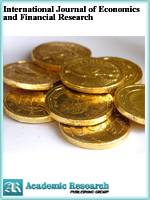International Journal of Economics and Financial Research
Online ISSN: 2411-9407
Print ISSN: 2413-8533
Print ISSN: 2413-8533
Quarterly Published (4 Issues Per Year)

Archives
Volume 6 Number 3 March 2020
Macroeconometric Assessment of Monetary Approach to Balance of Payments in a Small Open Economy: The Nigeria Experience
Authors: Atoi Ngozi Victor
Pages: 41-50
DOI: doi.org/10.32861/ijefr.63.41.50
Abstract
Monetary approach to balance of payment establishes a link between foreign reserve assets and money supply. This link is important for managing balance of payment disequilibrium through adjustment of monetary aggregates. This study relies on the (Polak, 1957;1997) monetary model with data from 2007:Q1 to 2018:Q4 to examine the link between monetary factors and balance of payment in Nigeria. To circumvent simultaneity, the reduced form coefficients of the structural form of the Polak model are estimated using Two Stage Least Squares (TSLS) technique, while the structural parameters are recovered from the estimated reduced form coefficients. The results are enriching and robust. The Johansen cointegration procedure suggests a long run relationship among the macroeconomic variables in the balance of payment function. The estimated balance of payment model reveals that domestic credit is statistically significant and negatively related to foreign reserve assets, implying that balance of payment is a monetary phenomenon in Nigeria. The velocity of money circulation and the marginal propensity to import are approximately 120 percent and 14 percent, respectively. The study therefore recommends that the monetary authority should consider the use of domestic credit for management of balance of payment disequilibrium. It is also pertinent to increase domestic credit to grow the economy since such action will marginally decrease external reserve assets through increase in import, however, the net effect will enhance the overall economy.
Overconfidence: The Influence of Positive and Negative Affect
Authors: Ibrahim Filiz
Pages: 29-40
DOI: doi.org/10.32861/ijefr.63.29.40
Abstract
The consequences of overconfidence affect many spheres of economic life. As yet, few factors are known that determine the extent of possible overconfidence. There are also few studies concerning the influence of positive and negative emotions on self-assessment. It has not yet been examined whether emotions can affect learning effects regarding self-assessment, wherefore the present study addresses this research question. In a real-effort-task experiment the participants are presented with tasks over the course of 5 rounds. After each round, they are asked to assess their own performance. They are then given feedback on their actual performance, thereby allowing for learning effects. Their mood is induced by positive (treatment “positive”), negative (treatment “negative”) and neutral (treatment “neutral”) movie clips. There are no significant differences in the three treatments regarding absolute and relative overconfidence. However, the participants’ moods differed with regard to the occurrence of learning effects. Obvious learning effects can be established in a neutral mood when examining absolute overconfidence. These learning effects cannot be detected in positive and negative moods.



